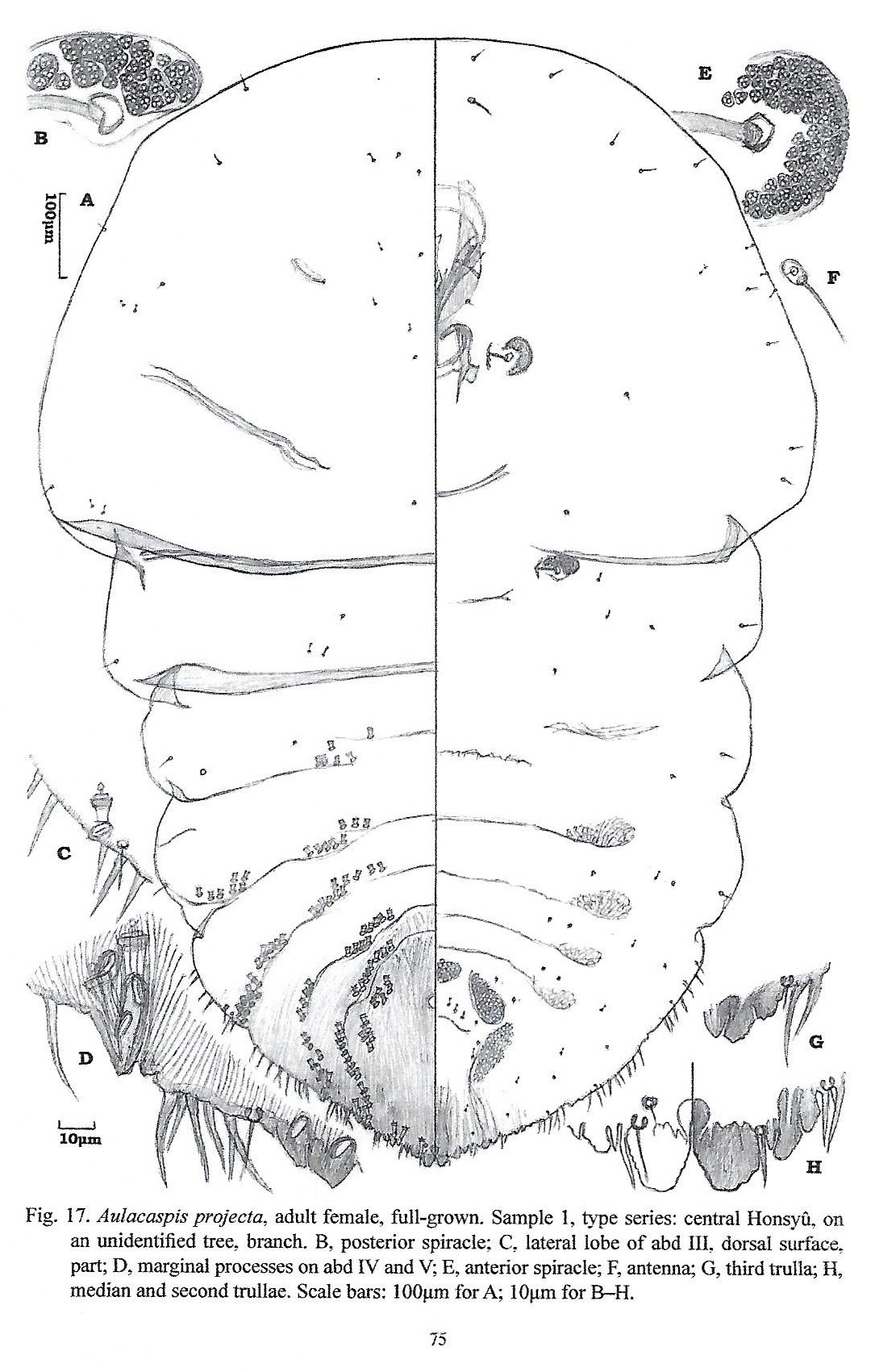Valid Names Results
Aulacaspis projecta Takagi, 1961 (Diaspididae: Aulacaspis)Nomenclatural History
- Aulacaspis projecta Takagi 1961a: 83. Type data: JAPAN: Honshu, Kurikara, on undetermined host, 23/06/1955. Syntypes, female, Type depository: Sapporo: Entomological Institute, Faculty of Agriculture, Hokkaido University, Japan; accepted valid name Illustr.
Common Names
Ecological Associates
Hosts:
Families: 7 | Genera: 7
- Cornaceae
- Cornus controversa | Takagi2018
- Lythraceae
- Lagerstroemia indica | Tang1986
- Meliaceae
- Meliaceae | DanzigPe1998
- Toona sinensis | Takagi2018 | (= Cedrella sinensis)
- Oleaceae
- Oleaceae | DanzigPe1998
- Styracaceae
- Pterostyrax hispidus | Takagi2018
- Styrax japonicus | Takagi2018
- Symplocaceae
- Symplocos | Takagi2018
- Thymelaeaceae
- Thymelaeaceae | DanzigPe1998
Geographic Distribution
Countries: 3
- China
- Japan
- Honshu | Takagi1961a
- Taiwan | Takagi2018
Keys
- JianXi2024: pp.595-597 ( Adult (F) ) [Aulacaspis from China]
- TianXi2022: pp.174-176 ( Adult (F) ) [Aulacaspis species from China]
- WeiJiZh2016: pp.21 ( Adult (F) ) [Aulacaspis from China]
- Chen1983: pp.34 ( Adult (F) ) [Key to species of Aulacaspis]
- Paik1978: pp.304 ( Adult (F) ) [Key to species of Aulacaspis]
- Takagi1961a: pp.88 ( Adult (F) ) [Key to species of Aulacaspis]
Remarks
- Systematics: Aulacaspis projecta is distinguished by its peculiar median lobes which are entirely produced beyond the apex of the pygidium. A. projecta is close to A. spinosa and A. difficilis, but can be told from them by the fact that it lacks gland spines on the 2nd abdominal segment. In the 2nd stage A. projecta has 4 marginal and 3 submarginal macroducts on each side of the body, whereas A. spinosa and A. difficilis lack submarginal macroducts, having merely 5 marginal ones on each side (Takagi, 1961a). A. projecta is also very similar to Aulacaspis kadsurae which occurs in central Honsyû and southern Japan. However, these species are remarkably different in the presence or absence of dorsal and lateral macroducts on abdominal segments and in the numbers of gland spines. In the second instar female, A. projecta is usually provided with single marginal macroducts on the fourth to seventh abdominal segments and single submarginal macroducts on the third to fifth segments, whereas A. kadsurae, while having single marginal macroducts on the third to seventh abdominal segments, lacks submarginal macroducts. (Takagi, 2018)
- Structure: Female scale circular, weakly convex dorsally and white (Takagi, 1961a). Adult female at full growth robust, with prosoma distinctly broader than postsoma, broadest subbasally; prosomatic tubercles slightly indicated at most; peribuccal scleroses well formed. Anterior spiracles each with a large crescent-shaped group of disc pores; posterior spiracles each also with many disc pores. Perivulvar disc pores numerous. (Takagi, 2018)
- General Remarks: Detailed description and illustration by Takagi (1961a).
Illustrations
Citations
- Borchs1966: catalog, distribution, host, taxonomy, 139
- Chen1983: description, distribution, host, illustration, taxonomy, 34, 49-50, 136
- Chou1985: description, distribution, taxonomy, 375
- Chou1986: illustration, 552
- DanzigPe1998: catalog, distribution, host, 198-199
- Hua2000: distribution, host, 148
- JianXi2024: key, 596
- Kawai1972: distribution, taxonomy, 37
- Kawai1980: distribution, illustration, taxonomy, 295-296
- KozarWa1985: catalog, distribution, 82
- Muraka1970: distribution, host, 87
- Paik1978: taxonomy, 304
- Takagi1961a: description, distribution, host, illustration, taxonomy, 75, 83-85, 88
- Takagi1970: taxonomy, 102
- Takagi2018: distribution, 53, 75-77
- TakagiKa1966: distribution, host, taxonomy, 114
- Tang1986: description, distribution, host, illustration, taxonomy, 190, 293
- Tao1999: distribution, host, 76
- TianXi2022: distribution, key, 174, 175
- WeiJiZh2016: key, 21



